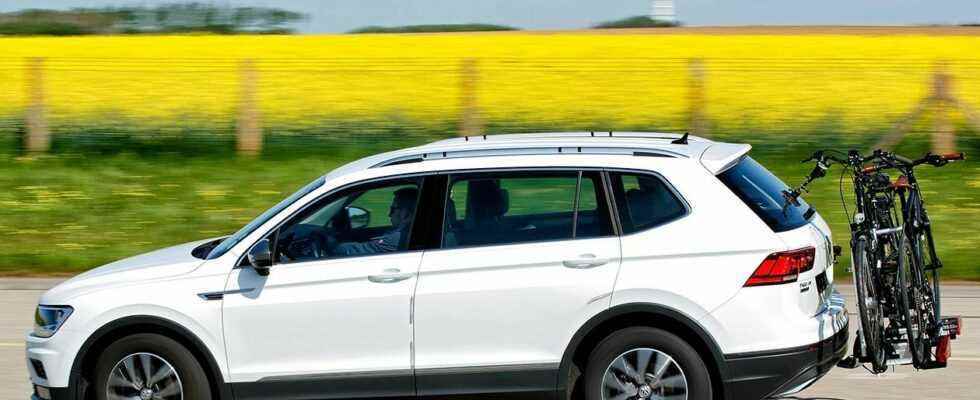There are basically three systems available for transporting bicycles by car: on the roof, at the rear or using a trailer hitch. In order to find out which method is best, the ÖAMTC subjected the systems to a comparative test. There was a clear winner.
And that means: wheel carrier for the trailer hitch. This solution performs best in all categories. It offers the most comfortable handling, the best safety and by far the lowest additional consumption. At 100 km/h the increase was four percent at 100 km/h, at 130 km/h it was plus six percent. With the roof rack, fuel consumption increases by 25 percent and 34 percent respectively, the rear rack causes an increase of 23 and 44 percent respectively. Two different e-bikes were tested on commercially available bikes – they pose a greater challenge due to their higher weight Carrier systems with which two e-bikes can be transported. The criteria handling (initial assembly, assembly/disassembly on the vehicle, loading and unloading the bicycles, access to the trunk), safety (city crash, emergency braking, swerving) and additional consumption were evaluated of 1.6 a good. “This system was pre-assembled, could be attached to the vehicle by one person and used immediately. Loading and unloading was also easy,” says ÖAMTC technician Steffan Kerbl. The crash test – a simulated rear-end collision at 30 km/h – left dents on the tailgate, but the e-bikes remained on the carrier. The only downside to the system is that a trailer hitch is required. “If the bike rack is to be used more often, it’s even worth retrofitting.” “The system itself is quick and easy to assemble, but two people are needed to load and unload the e-bikes,” explains Kerbl. In addition, the carriers are less or not at all suitable for heavy e-bikes. “Because of the weight, it’s very easy to overload the roof. In the crash test, this led to the cross member breaking, causing an e-bike to fall.” “Satisfactory” for rear carrier The rear carrier performed the worst with 2.9 and a satisfactory. “The final assembly of the system was complex and loading the e-bikes was difficult due to the mounting height, since neither the license plate nor the vehicle’s lights may be covered. Flatbed trailers, where this is easier, are expensive, and the additional installation of the electrical system on the vehicle is complex,” says Kerbl. In the event of a crash, there is a risk that the system, including the wheels, will fold backwards. ÖAMTC tips for using bicycle racks Before purchasing a bicycle transport system, you should clarify how many bicycles you want to transport, and what weight, and what options are available for your own vehicle are most suitable. The storage of the carrier system when it is not in use should also be considered in advance. Observe the weight limits of bicycle carriers and vehicles: The maximum payload of the bicycle carrier systems must be observed, as well as the maximum roof and support load depending on the system used, the carrier’s own weight and the permissible total weight of the vehicle. The license plate and lighting of the vehicle must be visible. If the lights are covered, you need a bike rack with the appropriate lighting equipment. If the number plate is covered, in Austria either the “normal white number plate” can be changed and attached to the bike carrier or a third (red) number plate can be applied for for this purpose, which then remains permanently on the bike carrier. With the red license plate with international distinguishing mark issued since April 2021, there should also be no problems when traveling abroad, the ÖAMTC reassured. When transporting, remove bulky, heavy or easy-to-lose parts from the bike, remove the e-bike batteries if possible . The heavier the bike to be transported, the closer it should be attached to the vehicle. Before setting off, carriers and bikes should be checked to ensure they are securely fastened. This check should generally be carried out again after a short journey and also at regular intervals on long journeys. Pay attention to changes in driving behavior: The carriers influence the driving behavior of the vehicle, which is why it can react unusually in extreme situations. When driving with rear carriers, it should be noted that the attached bicycle protrudes over the body on the right and left of many vehicles. Driving with a roof load changes the center of gravity of the vehicle. Driving style and speed must be adjusted accordingly, especially in cross winds and when cornering. Remove the carrier system when not in use – this reduces fuel consumption.
source site-13
